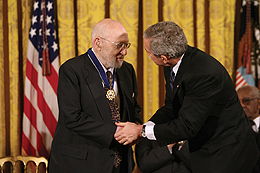|
|
 |
 |
|
OBITUARIESJoshua Lederberg ’44, Nobel, Presidential Medalist

President Bush presented the Medal of Freedom to Nobel Prize-winning microbiologist Joshua Lederberg ’44 on December 15, 2006. Photo: White House Photo by Eric Draper  Joshua Lederberg ’44, one of the 20th century’s leading scientists, died on February 2, 2008. He was 82 and lived in Manhattan, where he was Rockefeller University professor and president emeritus. Lederberg was just 33 when he won the Nobel for Physiology or Medicine for discovering that bacteria can mate and exchange genes. He was one of the youngest Nobelists, sharing the 1958 prize with Edward L. Tatum and George Beadle for their discovery at Stanford in the 1940s that genes act by regulating specific chemical processes. Lederberg’s discovery that bacteria engage in sex created new understandings of how bacteria evolve and acquire new traits, including drug resistance. A founder of the field of molecular biology, he helped lay the foundations for many biological revolutions, including biotechnology. Lederberg was born on May 23, 1925, in Montclair, N.J., to Zvi Hirsch Lederberg, a rabbi, and the former Esther Goldenbaum, who had emigrated from what is now Israel two years earlier. He was raised in Washington Heights and graduated from Stuyvesant H.S. in 1941, at 15. At Columbia, Lederberg studied zoology and earned a bachelor’s with honors at 19. He took some classes at P&S and in 1943 enrolled in a special Navy medical training program, working at St. Albans Naval Hospital in Queens, examining servicemen returning from war in the Pacific for parasites that cause malaria. After two years in medical school, Lederberg transferred to Yale and helped pioneer the field of bacterial genetics. He received his doctorate there in 1948 and then went to the University of Wisconsin, where he founded the medical genetics department. At Wisconsin, Lederberg helped prove that genetic mutations occurred spontaneously, confirming a long-held belief. Lederberg began his federal advisory career in 1957, when he joined President Eisenhower’s Science Advisory Committee. He advised nine White House administrations over a half-century. From 1966–71, Lederberg wrote a weekly column for The Washington Post, “Science and Man,” commenting on science education, scientists’ role in society and divisive topics like population control, intelligence testing and regulating recombinant DNA technology. From the start of the space age, Lederberg was fascinated by the possibility of extraterrestrial life; he coined the term exobiology, or the study of this possibility. He collaborated with astronomer Carl Sagan in establishing exobiology as a scientific discipline and in educating the public on the biological implications of space exploration. Lederberg was elected to membership in the National Academy of Sciences in 1957 and was made a charter member of its Institute of Medicine. In 1959, he joined the Stanford School of Medicine, where he chaired the genetics department and was a professor of biology and computer science, working on research in artificial intelligence, biochemistry and medicine. In 1978, he became Rockefeller’s fifth president, serving until 1990. Lederberg was a member of the Advisory Committee for Medical Research of the World Health Organization; an elected foreign member of the Royal Society, London; an honorary life member of the New York Academy of Sciences; and an honorary fellow of the New York Academy of Medicine. The College presented Lederberg with the Alexander Hamilton Medal in 1961, and he was the speaker at his class’ 50th reunion luncheon in 1994. In 1989, Lederberg received the U.S. National Medal of Science, and in 2006, President Bush awarded him the Presidential Medal of Freedom, the nation’s highest civilian honor. Lederberg’s first marriage, to Esther Lederberg, a microbiologist, ended in divorce in 1966. He is survived by his wife, Marguerite; children, Anne, and David Kirsch; and two grandchildren. For more on Lederberg, see the article in the last year's Columbia College Today. The National Library of Medicine also has a sampling of his papers, letters and articles. Lisa Palladino
|
|
||||||||||||||||||||||||||||




